.
FRANCE 2012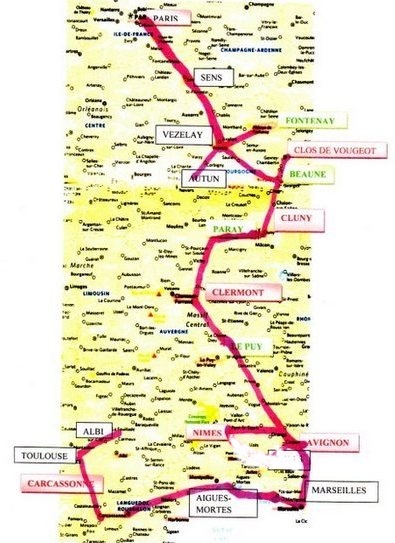
Day 14, Sunday, Sept. 16
MARSEILLE
We slept a little later than we intended, had breakfast, packed up (all
of the books we have been buying have certainly made our suit cases
heavy), got our car and headed to Marseille, which was an hour away.
Marseille, with nearly 1.5 million inhabitants, competes with Lyon for
the title of the second largest city in France, Paris being the largest.
Marseille is the oldest city, founded as a port by the Greeks in the
sixth century BC. The Phoenician (Greek) navigators seeking new
territory were attracted to this superb site with its deep harbor inlet
surrounded by generous and protective hills. The town was built to the
north of the harbor, called the Vieux Port. The fascinating history of
Marseille fills volumes which you can read for your own pleasure.
Alexander Dumas called Marseille "the meeting place of
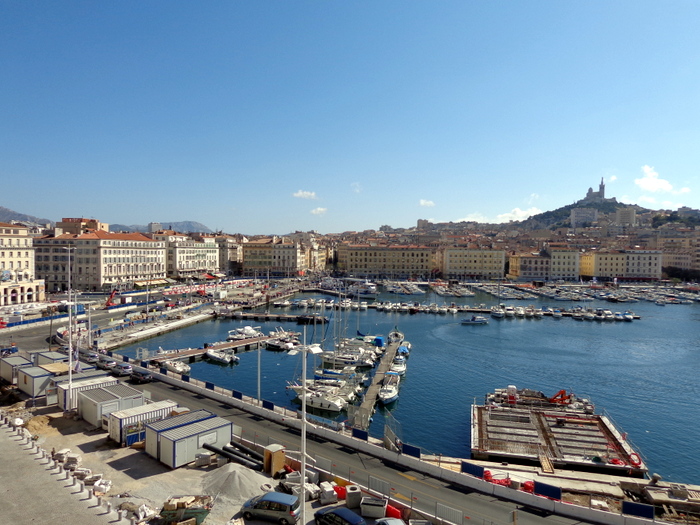 the entire
world."
the entire
world."
Frommer's describes it as "an industrial city with many faces, both
figuratively and literally, a view from high up reveals a colorful Vieux
port, with its elegant old buildings, boat filled harbor, and the
Mediterranean beyond. The city is sprawling and slum like in many
respects, but it also a place of unique sounds, smells, and sights
unlike any other in France. Its age-old problems include a drug
industry, smuggling, unemployed, the Mafia, and racial tension.
Nevertheless there is a strong city pride and an eye towards the future
as evidenced by the recent complete multimillion dollar euro tramway
installation and the ongoing extension of the Metro system". Marseille
has been chosen to be the 2013 European Capital of Culture. 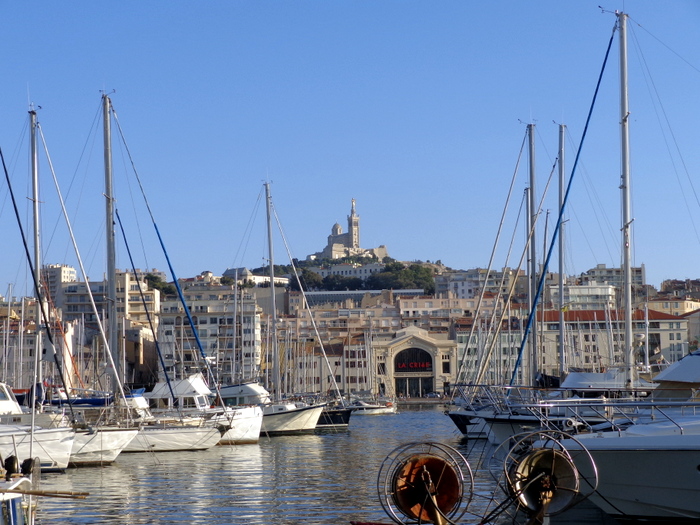
We had no trouble finding our way to our hotel- the Hotel La Residence,
which is located on the Vieux Port. We knew that there was construction
of a new plaza in front of our hotel, and we couldn’t enter that area.
The hotel had advised us to go down a back street, stop at the back
door, ring a bell and someone would help us. Our TomTom got us to the
right place, a very narrow street, Kathleen jumped out (with traffic
stopped behind us) rang the bell, a young lady popped out, took our
luggage and told us where to park. We finally found the parking
building which we thought was the wrong one, parked four levels down,
took the elevator up to a large court yard with lots of cafes, and we
had no idea where we were. We finally found our way out and regained
our bearings. Our hotel is located on the left side near the edge
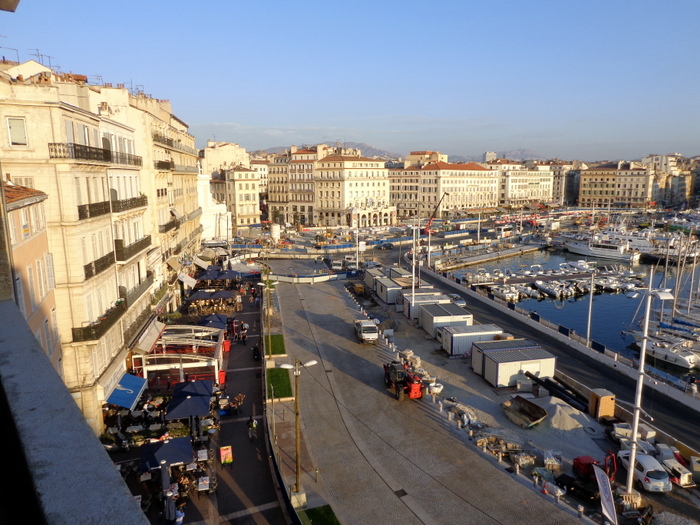 of
the old port. We hope that we will be able to find our car again; we
don’t intend to drive in Marseille.
of
the old port. We hope that we will be able to find our car again; we
don’t intend to drive in Marseille.
We walked several blocks back to our hotel through a lot of
construction. The British architect, Norman Foster , who had designed
the art museum that we visited two days ago in Nîmes, had designed a
re-development project for the old port that would allow for more
pedestrian traffic and less vehicular traffic, and open up space for
bars and restaurants, vendors and public events. This project was to be
completed next year. There was a lot of pedestrian traffic in the area
but cars were not allowed during the construction. The goal for this
reconstruction is to be finished in time for the celebration of
Marseille's honor of being chosen the 2013 European Capital of Culture.
We checked into Hotel La Residence, and asked for a higher floor room,
knowing we would get the ‘wow’ view from the upper floors. Our room was
not ready. It was about 2:00 and we hadn’t had lunch so we decided to
find an nice restaurant. As in other towns in France, there were many,
many outdoor cafes, which was the case on either side of the entrance to
the hotel. The view in front of the hotel is unbelievable, being the
ground-level view that we see from our room. We choose Petit Pernod
Café, sever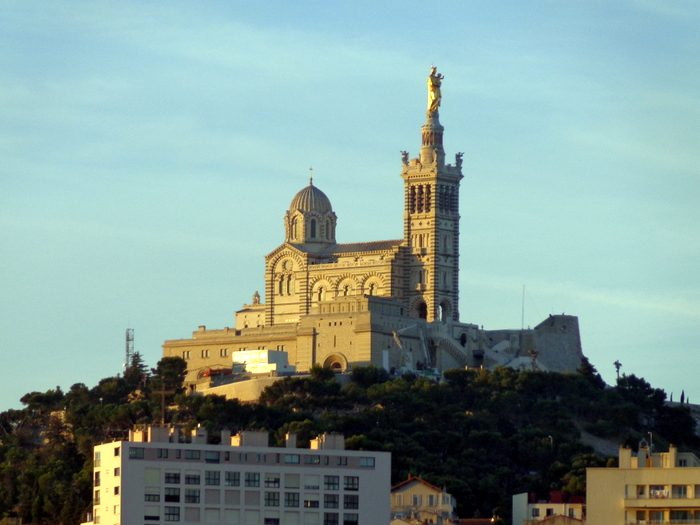 al doors down from our hotel. We both choose a salad.
Kathleen’s had three large pieces of chicken, avocados, tomatoes and
grapefruit. My salad had a nice piece of thin raw salmon, two large
shrimp, avocados, tomatoes, cheese, palm hearts and cheese. Both were
wonderful.
al doors down from our hotel. We both choose a salad.
Kathleen’s had three large pieces of chicken, avocados, tomatoes and
grapefruit. My salad had a nice piece of thin raw salmon, two large
shrimp, avocados, tomatoes, cheese, palm hearts and cheese. Both were
wonderful.
We walked several feet back to the hotel and found our room was ready.
We are on the 6th floor, facing the Old Port, complete with a nice size
balcony with comfortable chairs. We have a small room in the back for a
dressing room and an extra single bed. The view is unbelievable.
Across the water and up on the hill is the famous church of Notre Dame
de la Guard.
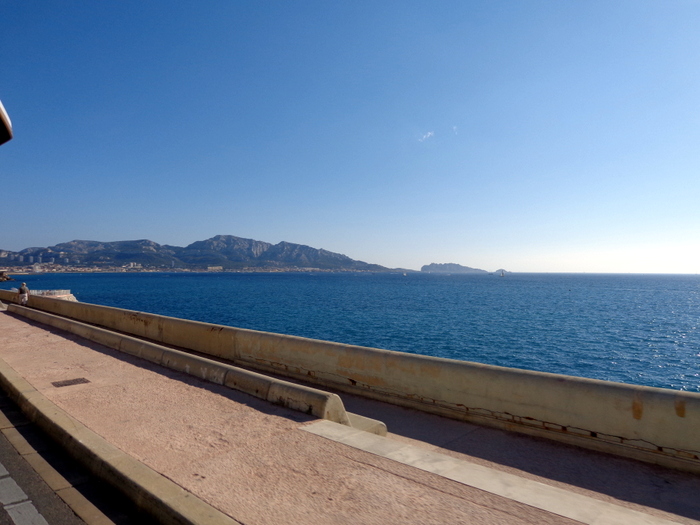 The desk clerk suggested that we take the Petit Train up to the
church. We walked several blocks down from the hotel and found the
stop for the little train, similar to the one we used in Avignon. The
train took us around the other side of the port, and we came out on the
Mediterranean- it was breath taking. We continued on the scenic route-up
and up and up to the church. We could get off at the church and stay as
long as we wanted. The little trains stopped for downhill passengers
every 20 minutes.
The desk clerk suggested that we take the Petit Train up to the
church. We walked several blocks down from the hotel and found the
stop for the little train, similar to the one we used in Avignon. The
train took us around the other side of the port, and we came out on the
Mediterranean- it was breath taking. We continued on the scenic route-up
and up and up to the church. We could get off at the church and stay as
long as we wanted. The little trains stopped for downhill passengers
every 20 minutes. 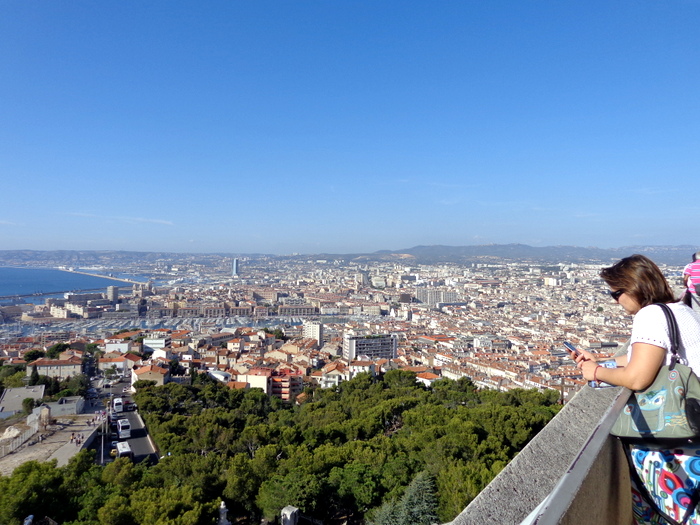
Guess what? More steps. Then we found an elevator to take us up to
the church. The view from the church was amazing. You can see all of
Marseille – the mountains, the Mediterranean, large ships, the whole
city. I don’t think I have ever seen anything like it. It was
breathtaking.
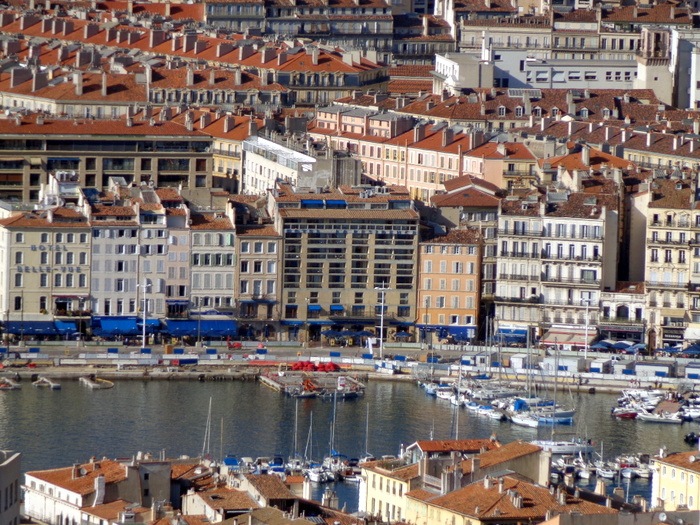
This is a zoomed lens photo of our hotel which is in the center of the
photo, the building with the blue awnings on the top. Our room is next to the top on the
left side.
The site of the church,
Notre Dame de le Garde dates back to 1214 when
the Abbott of St. Victor Abbey in Marseille, allowed Maitre Pierre to
build a small chapel on the hill of La Garde. The name of the hill was
called La Garde because it was from the summit of this hill that those
in charge with the safety the town would sit and watch, guarding those
below - thus the "hill of the guards". In the years that followed 1400,
the first oratory was replaced by a more beautiful chapel. Less than a
century later, a third chapel was built. In 1853, a new church was
built, but only after much discussion. The Ministry of War had to be
persuaded to abandon the fort and accept that a Basilica be constructed
in its
a small chapel on the hill of La Garde. The name of the hill was
called La Garde because it was from the summit of this hill that those
in charge with the safety the town would sit and watch, guarding those
below - thus the "hill of the guards". In the years that followed 1400,
the first oratory was replaced by a more beautiful chapel. Less than a
century later, a third chapel was built. In 1853, a new church was
built, but only after much discussion. The Ministry of War had to be
persuaded to abandon the fort and accept that a Basilica be constructed
in its
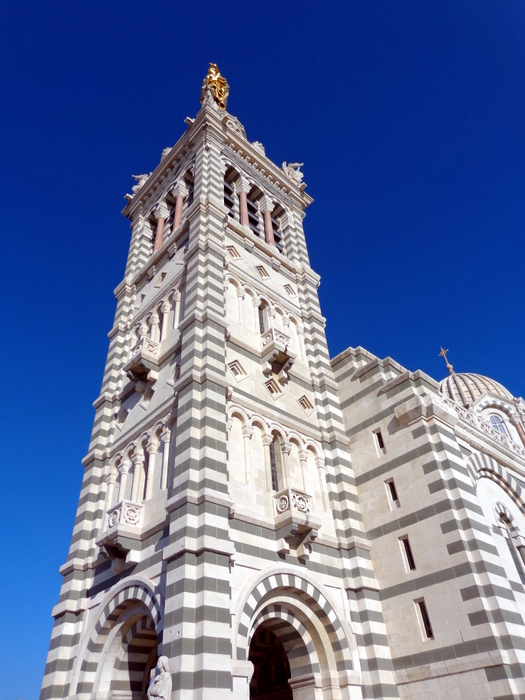 place. The new Basilica was consecrated in 1864. The exterior
of the building is notable for its layered stonework in contrasting
colors: white Calissane limestone alternates with layers of green
Golfalina stone in a style reminiscent of Florence.
place. The new Basilica was consecrated in 1864. The exterior
of the building is notable for its layered stonework in contrasting
colors: white Calissane limestone alternates with layers of green
Golfalina stone in a style reminiscent of Florence.
The 130 ft the square bell tower above the entrance porch can be seen
from great distances around Marseille. It has two identical stories of
five blind arches, with the central arch bearing a window with a small
balcony. This is surmounted by a belfry, with each face made up of three
large bays divided by red granite columns. This belfry is topped by a
bordered square terrace with an openwork stone baluster bearing the arms
of the city on each side and an angel with a trumpet at each corner.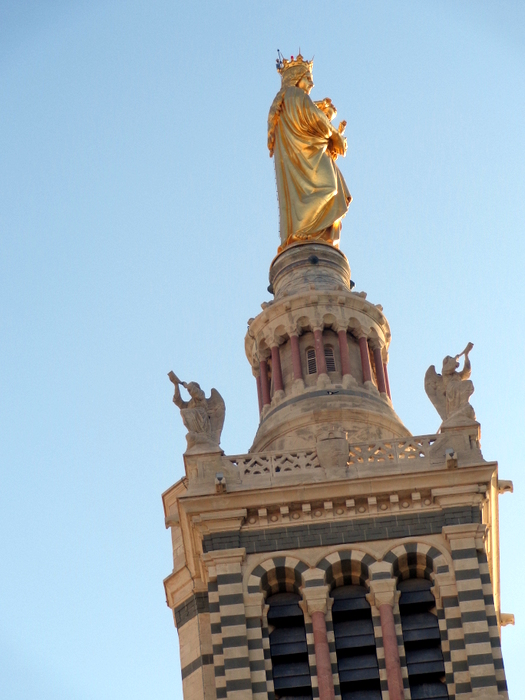
From the square terrace a cylindrical bell tower rises to a height
of 40 feet. It is made of sixteen red granite columns supporting a
monumental statue of the Virgin Mary,36 feet tall. A staircase within
the bell tower allows access to the terrace and to the statue.
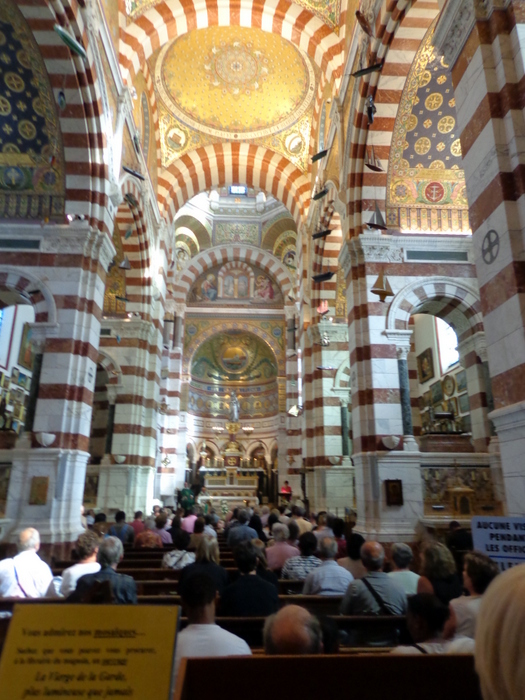 The entire church interior has breathtaking mosaics, which were
not added until the 19th century. From the entrance to the Basilica, the
eye is drawn to the statue of Notre Dame de la Garde (Mary) that sits on
a red marble column. The silver statue, whose artist worked for six
years to achieve this masterpiece, was completed in 1837.
The entire church interior has breathtaking mosaics, which were
not added until the 19th century. From the entrance to the Basilica, the
eye is drawn to the statue of Notre Dame de la Garde (Mary) that sits on
a red marble column. The silver statue, whose artist worked for six
years to achieve this masterpiece, was completed in 1837.
The apse that
surrounds the stat ue is covered with very fine mosaics. They represent
all of creation. In the center of the top of the vault of the apse can
be found a large medallion with a sailing boat, whose blue and white
sail bear the arms of Mary and of Marseille: on a sea with waves topped
with white spume of a storm; it moves towards a glowing light house. In
the sky a star shines – Mary who watches over the church.
ue is covered with very fine mosaics. They represent
all of creation. In the center of the top of the vault of the apse can
be found a large medallion with a sailing boat, whose blue and white
sail bear the arms of Mary and of Marseille: on a sea with waves topped
with white spume of a storm; it moves towards a glowing light house. In
the sky a star shines – Mary who watches over the church.
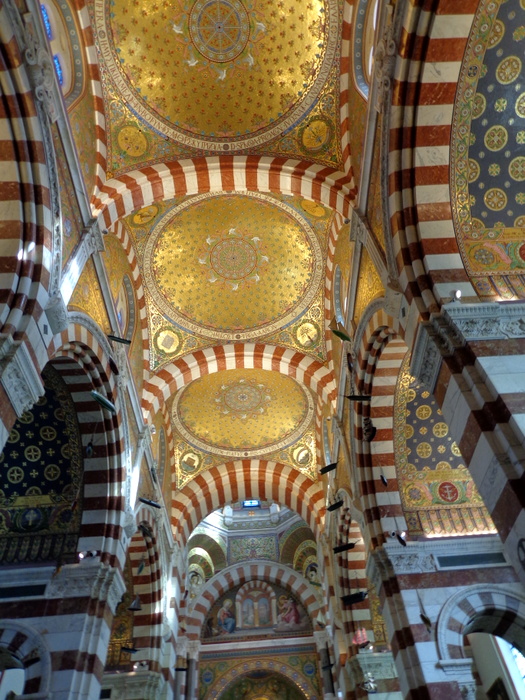
Looking up from the nave, there are three cupolas which are covered in
very rich mosaics dominated by gold and blues that represent the power
of God. The first cupola represents the Patriarchs, and the second Moses
and the third cupola the Prophets.
Mass was going on when we entered. A young lady was reading one of the
lessons so we decided to go out for a while since we didn’t understand
the French. We walked around outside admiring the breathtaking views and
then returned for the Eucharist. The church was almost completely
full. We bought a book in the bookstore. I looked for a model but
didn’t see any.
We found the next little train and took it back down the hill. It was
6:30, and we discovered a café that had Jack Daniels. We returned to
the ro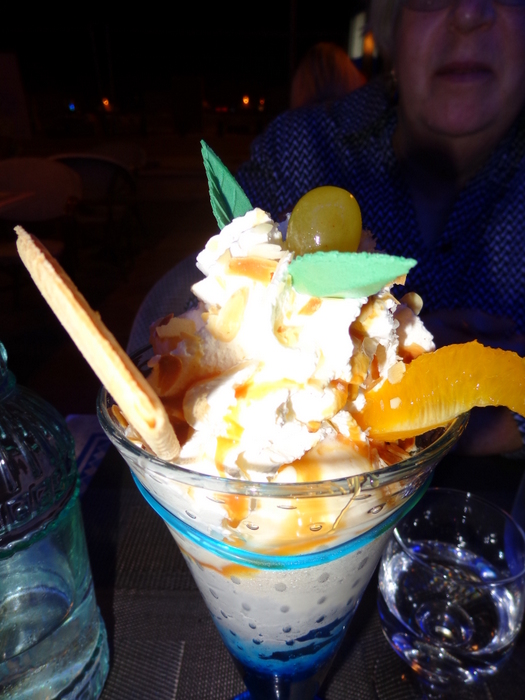 om for a few minutes and went to an outdoor café called La Chope
D’or (Kathleen hadn’t made reservations for tonight because most
restaurants are closed Sunday evening). They also had Jack Daniels
plus we both had Poelee De St. Jacque which was small scallops in a
cream sauce with rice and roasted vegetables. The service was fast and
the food was tasty – not the best that we have eaten. We shared a
decadent looking dessert with ice cream, fruit and whipped cream.
om for a few minutes and went to an outdoor café called La Chope
D’or (Kathleen hadn’t made reservations for tonight because most
restaurants are closed Sunday evening). They also had Jack Daniels
plus we both had Poelee De St. Jacque which was small scallops in a
cream sauce with rice and roasted vegetables. The service was fast and
the food was tasty – not the best that we have eaten. We shared a
decadent looking dessert with ice cream, fruit and whipped cream.
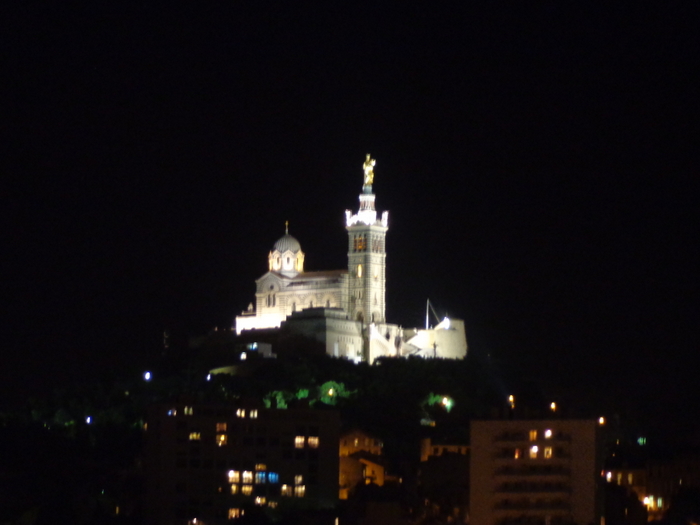 We came home, and admired all of the wonderful lights of the area and
the church on top of the hill. We have some fun things planned for
tomorrow.
We came home, and admired all of the wonderful lights of the area and
the church on top of the hill. We have some fun things planned for
tomorrow.

 the entire
world."
the entire
world." 
 of
the old port. We hope that we will be able to find our car again; we
don’t intend to drive in Marseille.
of
the old port. We hope that we will be able to find our car again; we
don’t intend to drive in Marseille. al doors down from our hotel. We both choose a salad.
Kathleen’s had three large pieces of chicken, avocados, tomatoes and
grapefruit. My salad had a nice piece of thin raw salmon, two large
shrimp, avocados, tomatoes, cheese, palm hearts and cheese. Both were
wonderful.
al doors down from our hotel. We both choose a salad.
Kathleen’s had three large pieces of chicken, avocados, tomatoes and
grapefruit. My salad had a nice piece of thin raw salmon, two large
shrimp, avocados, tomatoes, cheese, palm hearts and cheese. Both were
wonderful.  The desk clerk suggested that we take the Petit Train up to the
church. We walked several blocks down from the hotel and found the
stop for the little train, similar to the one we used in Avignon. The
train took us around the other side of the port, and we came out on the
Mediterranean- it was breath taking. We continued on the scenic route-up
and up and up to the church. We could get off at the church and stay as
long as we wanted. The little trains stopped for downhill passengers
every 20 minutes.
The desk clerk suggested that we take the Petit Train up to the
church. We walked several blocks down from the hotel and found the
stop for the little train, similar to the one we used in Avignon. The
train took us around the other side of the port, and we came out on the
Mediterranean- it was breath taking. We continued on the scenic route-up
and up and up to the church. We could get off at the church and stay as
long as we wanted. The little trains stopped for downhill passengers
every 20 minutes. 
 a small chapel on the hill of La Garde. The name of the hill was
called La Garde because it was from the summit of this hill that those
in charge with the safety the town would sit and watch, guarding those
below - thus the "hill of the guards". In the years that followed 1400,
the first oratory was replaced by a more beautiful chapel. Less than a
century later, a third chapel was built. In 1853, a new church was
built, but only after much discussion. The Ministry of War had to be
persuaded to abandon the fort and accept that a Basilica be constructed
in its
a small chapel on the hill of La Garde. The name of the hill was
called La Garde because it was from the summit of this hill that those
in charge with the safety the town would sit and watch, guarding those
below - thus the "hill of the guards". In the years that followed 1400,
the first oratory was replaced by a more beautiful chapel. Less than a
century later, a third chapel was built. In 1853, a new church was
built, but only after much discussion. The Ministry of War had to be
persuaded to abandon the fort and accept that a Basilica be constructed
in its
 place. The new Basilica was consecrated in 1864. The exterior
of the building is notable for its layered stonework in contrasting
colors: white Calissane limestone alternates with layers of green
Golfalina stone in a style reminiscent of Florence.
place. The new Basilica was consecrated in 1864. The exterior
of the building is notable for its layered stonework in contrasting
colors: white Calissane limestone alternates with layers of green
Golfalina stone in a style reminiscent of Florence. 
 The entire church interior has breathtaking mosaics, which were
not added until the 19th century. From the entrance to the Basilica, the
eye is drawn to the statue of Notre Dame de la Garde (Mary) that sits on
a red marble column. The silver statue, whose artist worked for six
years to achieve this masterpiece, was completed in 1837.
The entire church interior has breathtaking mosaics, which were
not added until the 19th century. From the entrance to the Basilica, the
eye is drawn to the statue of Notre Dame de la Garde (Mary) that sits on
a red marble column. The silver statue, whose artist worked for six
years to achieve this masterpiece, was completed in 1837.  ue is covered with very fine mosaics. They represent
all of creation. In the center of the top of the vault of the apse can
be found a large medallion with a sailing boat, whose blue and white
sail bear the arms of Mary and of Marseille: on a sea with waves topped
with white spume of a storm; it moves towards a glowing light house. In
the sky a star shines – Mary who watches over the church.
ue is covered with very fine mosaics. They represent
all of creation. In the center of the top of the vault of the apse can
be found a large medallion with a sailing boat, whose blue and white
sail bear the arms of Mary and of Marseille: on a sea with waves topped
with white spume of a storm; it moves towards a glowing light house. In
the sky a star shines – Mary who watches over the church.  om for a few minutes and went to an outdoor café called La Chope
D’or (Kathleen hadn’t made reservations for tonight because most
restaurants are closed Sunday evening). They also had Jack Daniels
plus we both had Poelee De St. Jacque which was small scallops in a
cream sauce with rice and roasted vegetables. The service was fast and
the food was tasty – not the best that we have eaten. We shared a
decadent looking dessert with ice cream, fruit and whipped cream.
om for a few minutes and went to an outdoor café called La Chope
D’or (Kathleen hadn’t made reservations for tonight because most
restaurants are closed Sunday evening). They also had Jack Daniels
plus we both had Poelee De St. Jacque which was small scallops in a
cream sauce with rice and roasted vegetables. The service was fast and
the food was tasty – not the best that we have eaten. We shared a
decadent looking dessert with ice cream, fruit and whipped cream.  We came home, and admired all of the wonderful lights of the area and
the church on top of the hill. We have some fun things planned for
tomorrow.
We came home, and admired all of the wonderful lights of the area and
the church on top of the hill. We have some fun things planned for
tomorrow. 